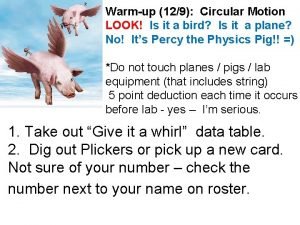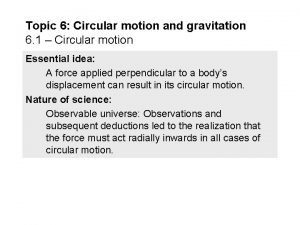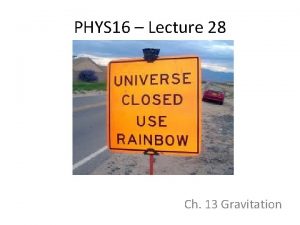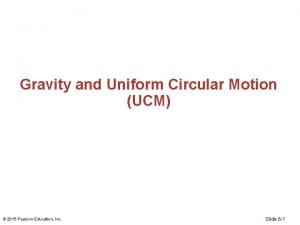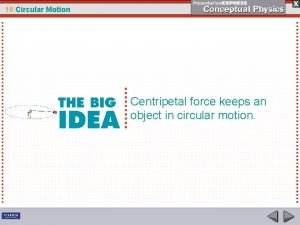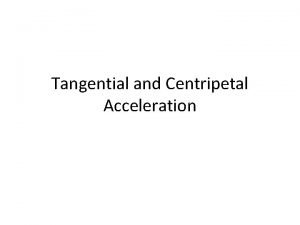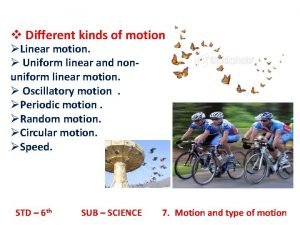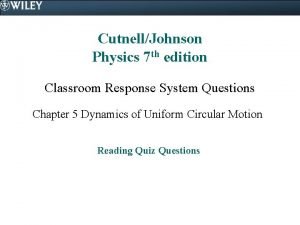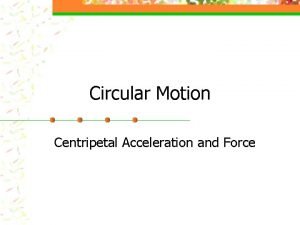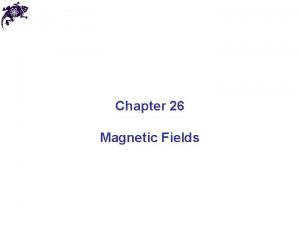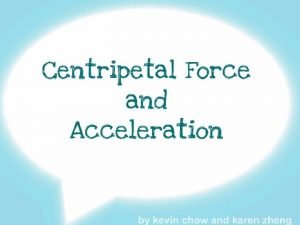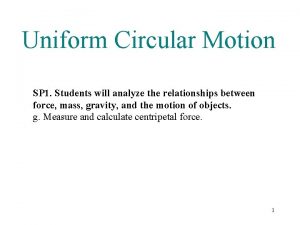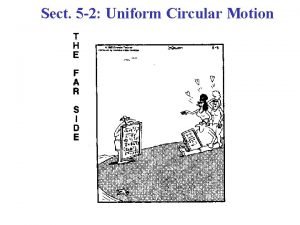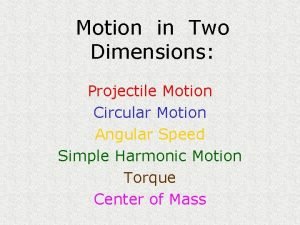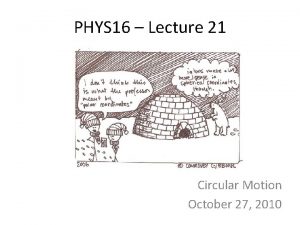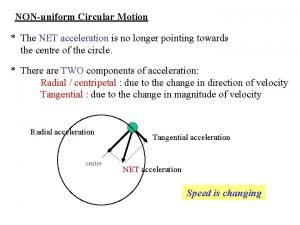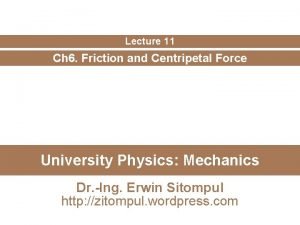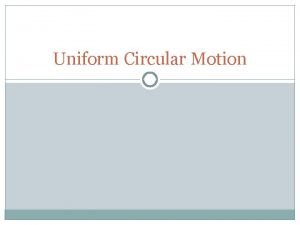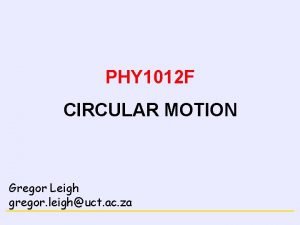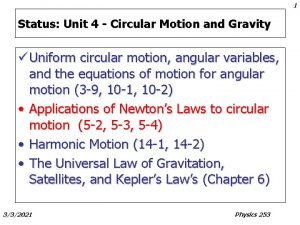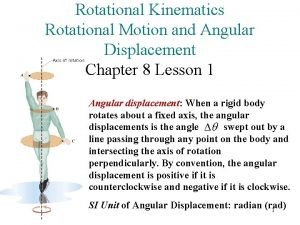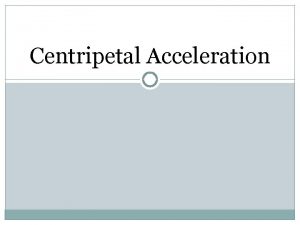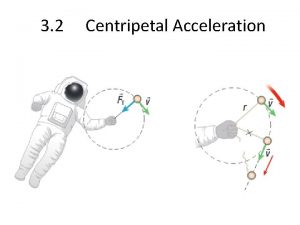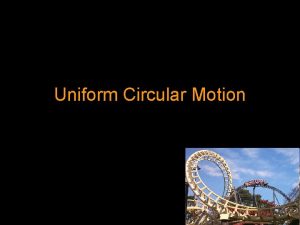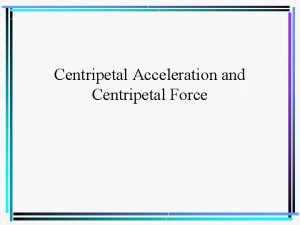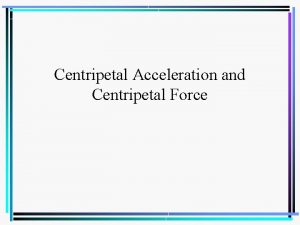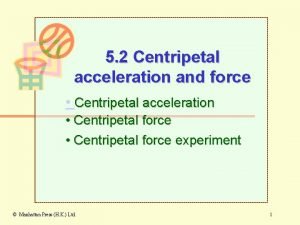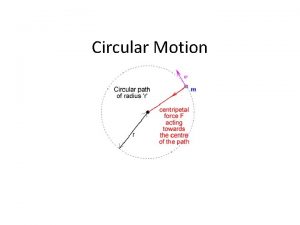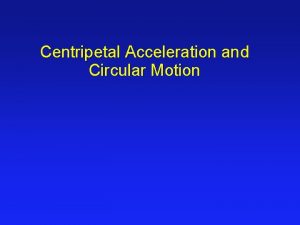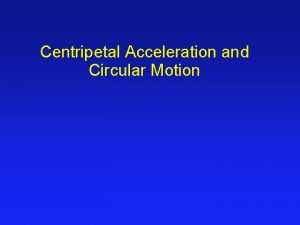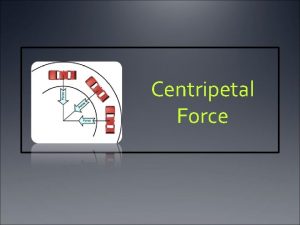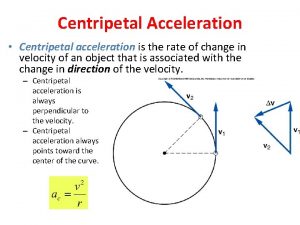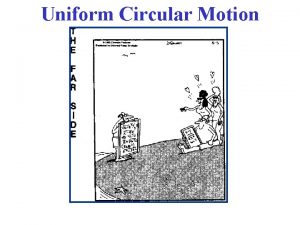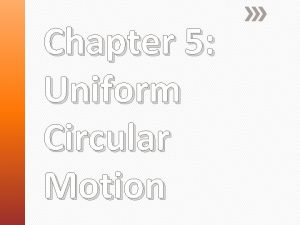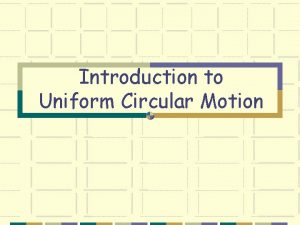Circular Motion Centripetal Force and Acceleration Uniform Circular





























- Slides: 29

Circular Motion Centripetal Force and Acceleration

Uniform Circular Motion Suppose you were driving a car in a path of perfect circle with the radius constant. Your speedometer maintained a constant reading of 10 mi/hr. In such a situation, the motion of your can be described as experiencing uniform circular motion. (Circular Motion at a constant speed)

The Direction of the Velocity Vector? Objects moving in uniform circular motion have a constant speed, but does that mean they have a constant velocity? Since an object is moving in a circle, its direction is continuously changing. Although the magnitude of the velocity is constant, its direction is changing.

The Direction of the Velocity Vector? The best word used to describe the direction of the velocity vector is tangential. The direction of the velocity vector at any instant is in the direction of a tangent line drawn to the circle. A tangent line is a line that touches a circle at one point but does not intersect it.

SUMMARY An object moving in uniform circular motion is moving around the perimeter of the circle with a constant speed. While the speed of the object is constant, its velocity is changing. Velocity, being a vector, has a constant magnitude but a changing direction. The direction is always directed tangent to the circle and as the object turns the circle, the tangent line is always pointing in a new direction.

CHECKPOINT A tube has been placed upon the table and shaped into a threequarters circle. A golf ball is pushed into the tube at one end at high speed. The ball rolls through the tube and exits at the opposite end. Describe the path of the golf ball as it exits the tube.

ANSWER The ball will move along a path which is tangent to the spiral at the point where it exits the tube. At that point, the ball will no longer curve or spiral, but rather travel in a straight line in the tangential direction

ACCELERATION If you were driving a car in a circle at a constant speed of 20 mi/hr, would the car be accelerating?

YES Remember, acceleration is defined as the change in an object’s velocity ( not speed). A change in the magnitude or direction of an object’s velocity constitutes a change in its acceleration.

Direction of Acceleration In order to determine the direction the object’s acceleration, we have to use the equation. We need to subtract vi from vf, but since they are vectors, we have to ad them graphically. The direction of the acceleration is inward, towards the center of the circle.

SUMMARY Objects moving in a circle at constant speed experience an acceleration that is directed towards the center of the circle.

CHECKPOINT The initial and final speed of a ball at two different points in time is shown below. The direction of the ball is indicated by the arrow. For each case, indicate if there is an acceleration. Explain why or why not. Indicate the direction of the acceleration.

ANSWER There is no acceleration , because there is not change in velocity The velocity vectors cancel each other out.

EXAMPLE #2

ANSWER #2 Yes, there is an acceleration because the object experienced a change in its velocity. The direction of the acceleration is by 5 m/s, east(right)

EXAMPLE #3

ANSWER #3 There is a change in the velocity due to the different directions of the velocity vectors. The acceleration will be to the west (left)

Classwork Complete 7. 1 Worksheet

Centripetal Force • An object experiencing an acceleration must also experience a net force. • The direction of the net force must be in the same direction as the acceleration. • An object moving in a circle must have an inward force acting upon it in order to cause its inward acceleration. • Centripetal – Means “center-seeking”

Centripetal Force explained st by Newton’s 1 Law According to Newton’s 1 st Law – all moving objects continue to move in the same direction unless acted upon by an unbalanced force. Moving objects will tend to travel in straight lines unless an unbalanced force causes it to turn. Therefore; an unbalanced force is required for an object to move in circles.

Centripetal Force If an object moves in a circle, there is some net force acting on it, causing it to deviate from its straight-line path. As a car makes a turn, the force of friction acting upon the turned wheels of the car provides centripetal force required for circular motion. As a bucket of water is tied to a string and spun in a circle, the tension force acting upon the bucket provides the centripetal force required for circular motion. As the moon orbits the Earth, the force of gravity acting upon the moon provides the centripetal force required for circular motion.

CHECKPOINT Which vector below represents the direction of the force vector when the object is located at point A on the circle?

ANSWER D

CHECKPOINT #2 Which vector below represents the direction of the velocity vector when the object is located at point C on the circle?

ANSWER A – The vector that is tangent to the Point C on the circle.

CHECKPOINT #3 Which vector below represents the direction of the acceleration vector when the object is located at point A on the circle?

ANSWER D- Acceleration vector always points inward towards the unbalanced force.

EQUATIONS Tangential Speed Vt = 2πr / T

CLASSWORK / HOMEWORK PAGE 236 #’S 1 -4 PAGE 238 #’S 1 -4
 Centripetal acceleration is
Centripetal acceleration is Centripetal acceleration symbol
Centripetal acceleration symbol Centripetal acceleration tangential acceleration
Centripetal acceleration tangential acceleration Radial acceleration
Radial acceleration 6-1 centripetal acceleration and force
6-1 centripetal acceleration and force 6-1 centripetal acceleration and force
6-1 centripetal acceleration and force Centripetal force and gravitational force
Centripetal force and gravitational force A car turns a corner on a banked road
A car turns a corner on a banked road Which arrow below represents the direction of acceleration
Which arrow below represents the direction of acceleration If you whirl a tin can on the end of a string
If you whirl a tin can on the end of a string Centripetal vs centrifugal force geography
Centripetal vs centrifugal force geography Tangential speed
Tangential speed Linear motion images
Linear motion images Centripetal acceleration unit
Centripetal acceleration unit Centripetal acceleration physics classroom
Centripetal acceleration physics classroom Missy's favorite ride at the topsfield fair is the rotor
Missy's favorite ride at the topsfield fair is the rotor Magnetic torque
Magnetic torque Is centripetal force a vector quantity
Is centripetal force a vector quantity Centripetal acceleration
Centripetal acceleration Circular motion definition
Circular motion definition Acceleration formula in circular motion
Acceleration formula in circular motion Circular motion
Circular motion Non uniform circular motion
Non uniform circular motion Friction and centripetal force
Friction and centripetal force Uniform circular motion lab answer key
Uniform circular motion lab answer key Non uniform circular motion
Non uniform circular motion Non uniform circular motion examples
Non uniform circular motion examples Dynamics of uniform circular motion
Dynamics of uniform circular motion Translational motion diagram
Translational motion diagram Si unit for angular displacement
Si unit for angular displacement

